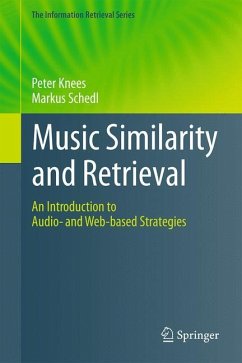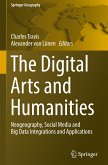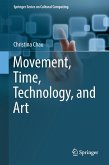This book provides a summary of the manifold audio- and web-based approaches to music information retrieval (MIR) research. In contrast to other books dealing solely with music signal processing, it addresses additional cultural and listener-centric aspects and thus provides a more holistic view. Consequently, the text includes methods operating on features extracted directly from the audio signal, as well as methods operating on features extracted from contextual information, either the cultural context of music as represented on the web or the user and usage context of music.
Following the prevalent document-centered paradigm of information retrieval, the book addresses models of music similarity that extract computational features to describe an entity that represents music on any level (e.g., song, album, or artist), and methods to calculate the similarity between them. While this perspective and the representations discussed cannot describe all musical dimensions,theyenable us to effectively find music of similar qualities by providing abstract summarizations of musical artifacts from different modalities.
The text at hand provides a comprehensive and accessible introduction to the topics of music search, retrieval, and recommendation from an academic perspective. It will not only allow those new to the field to quickly access MIR from an information retrieval point of view but also raise awareness for the developments of the music domain within the greater IR community. In this regard, Part I deals with content-based MIR, in particular the extraction of features from the music signal and similarity calculation for content-based retrieval. Part II subsequently addresses MIR methods that make use of the digitally accessible cultural context of music. Part III addresses methods of collaborative filtering and user-aware and multi-modal retrieval, while Part IV explores current and future applications of music retrieval and recommendation.>
Following the prevalent document-centered paradigm of information retrieval, the book addresses models of music similarity that extract computational features to describe an entity that represents music on any level (e.g., song, album, or artist), and methods to calculate the similarity between them. While this perspective and the representations discussed cannot describe all musical dimensions,theyenable us to effectively find music of similar qualities by providing abstract summarizations of musical artifacts from different modalities.
The text at hand provides a comprehensive and accessible introduction to the topics of music search, retrieval, and recommendation from an academic perspective. It will not only allow those new to the field to quickly access MIR from an information retrieval point of view but also raise awareness for the developments of the music domain within the greater IR community. In this regard, Part I deals with content-based MIR, in particular the extraction of features from the music signal and similarity calculation for content-based retrieval. Part II subsequently addresses MIR methods that make use of the digitally accessible cultural context of music. Part III addresses methods of collaborative filtering and user-aware and multi-modal retrieval, while Part IV explores current and future applications of music retrieval and recommendation.>
"Knees and Schedl's book on Music similarity and retrieval differs from other books on the topic in that the authors have focused on music rather than acoustical signal processing, adding several cultural- and listener-centric aspects thereby rendering a holistic view. As a result, we find not only methods working on musical characteristics retrieved from the audio signal, but also techniques working on characteristics obtained from contextual information ... Although not a textbook, I would definitely recommend it as handy reference material for music researchers, postgraduate students, and teachers of music or musicology." (Soubhik Chakraborty, Computing Reviews, February, 2017)








